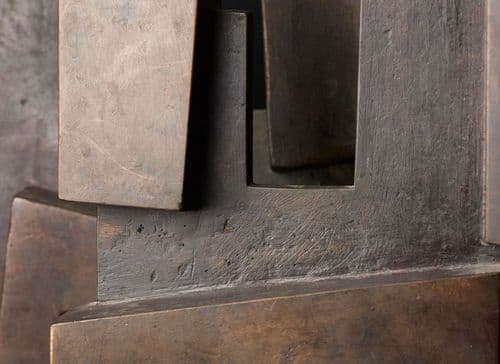
Lot 20

ROBERT ADAMS (BRITISH 1917-1984) §
TWO CURVES, 1959 (OPUS 78)












Auction: Evening Sale (Lots 1 to 51) - 25 April at 6pm
Description
bronzed steel
Dimensions
190.5cm high, 52cm wide, 31cm deep (75in high, 20 1/2in wide, 12 1/8in deep)
Provenance
The Estate of the Artist;
Gimpel Fils, London.
Footnote
ROBERT ADAMS (1917 - 1984)
TWO CURVES 1959, OPUS 78
"The neglected genius of post-war British sculpture". (Brian Glasser, 3 February 1993, "none". Time Out. p. 37.)
Standing nearly 2m tall, Two Curves is constructed from a single metal rod attached to a square base with a flat metal top. Mounted in both portrait and landscape profiles two rectangular metal sheets bend inwardly away from the viewer to add body to this simple structure. In so doing they enable the sculpture to create the impression of shapes and forms beyond its physical appearance.
Achieving his first success just three years after graduating Northampton Art School with a solo show at Gimpel Fils in 1947 Robert Adams’s early work exemplified Henry Moore’s credo ‘truth to material’, demonstrating a sensitivity to the natural properties of the materials. During this period Adams’s sculpture continually evolved towards pure abstract forms, asymmetric balance and a focused awareness of space so that by 1950 he had completely removed the presence of the human figure. Adams also exhibited in the British Pavilion at the now infamous Venice Biennale, 1952. Alongside his compatriots his work grabbed the attention of the art world becoming known as the Geometry of Fear because of its spiky, alien-looking twisted and tortured figures. Created in pitted bronze or welded metal these sculptures expressed the anxieties and emotions of the post-war period.
Created in 1959, Two Curves tells the story of Adams’s artistic journey through a heavily politicized period in history and encourages an interpretation that relates to the themes of the time. However, by applying a purely descriptive title to this abstract work Adams also allows its interpretation to move beyond its time to take on new meaning and relevance within the contemporary spaces of today’s world.












